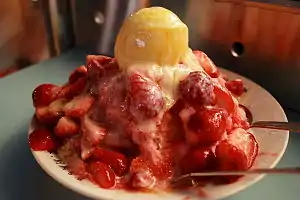Baobing
Baobing (Chinese: 刨冰; pinyin: bàobīng), also known by its Taiwanese Hokkien name Tsuabing (Chinese: 礤冰; Pe̍h-ōe-jī: chhoah-peng),[1] is a shaved ice dessert found in Greater China and countries with large overseas Chinese populations such as Malaysia.[2] It is especially popular in Taiwan where the dish has a variation called xuehua bing (雪花冰).
 A plate of bàobīng with strawberries and condensed milk | |
| Type | Shaved ice |
|---|---|
| Place of origin | China |
| Region or state | East Asia |
Shaved ice was eaten in China as early as the seventh century AD during the Tang Dynasty in northern China. In 1972, when President Richard M. Nixon made his first visit to Beijing, shaved ice was served during state dinners with Mao Zedong and Zhou Enlai.[3]
The dessert consists of a large mound of ice shavings with various toppings on top. A wide variety of toppings exist, but the most common ones include sugar water, condensed milk, adzuki beans, mung beans, and tapioca balls. Fruit are also used according to the season. Mango baobing is typically only available in the summer, while strawberry baobing is available in the winter.
Traditionally, these shavings were created by hand using a large mallet to crush ice or a blade to shave ice. Now, most stores use machines, which result in finer, thinner ice shavings.
See also
- Kakigōri, the Japanese shaved-ice variant
- Patbingsu, the Korean shaved-ice variant
- Air batu campur, the Malaysian shaved-ice variant
- Halo-halo, the Philippine shaved-ice variant
- Namkhaeng sai, the Thai shaved-ice variant
- Shave ice, the Hawaiian variant
References
- "Entry #13026". 臺灣閩南語常用詞辭典 [Dictionary of Frequently-Used Taiwan Minnan]. (in Chinese and Hokkien). Ministry of Education, R.O.C. 2011.
- Filloon, Whitney (2018-05-24). "Everything You Need to Know About Shaved Ice Desserts". Eater. Retrieved 2020-06-23.
- "The Americanization of Bao Bing, a Cool, Fruity Asian Treat" New York Times, 7 June 1989
| Wikimedia Commons has media related to Baobing. |
